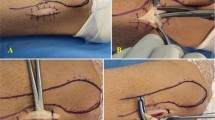Abstract
To determine the features of a successful clinical strategy, we analyzed the results of 100 consecutive lower extremity vascular reconstructions performedexclusively for tissue loss and gangrene of the legs and feet. Eighty patients underwent 100 procedures on 80 limbs. Follow-up was 95% complete (every six months, mean 2.2 years). Forty inflow procedures to the femoral artery were performed with 13 simultaneous infrainguinal bypasses. Sixty bypasses were performed from the femoral artery to the popliteal (25) or tibial arteries (35). Sixty-eight percent of the identified ulcerations healed, and limb salvage was achieved in 70% of patients by life-table analysis. The cumulative patency for all reconstructions was 48% (five years), for tibial bypasses 60% (four years). Femoropoliteal bypasses had the poorest patency and healing rates (<40%), while combined inflow-outflow procedures and femorotibial bypasses had the highest rates of healing (77%, 66%). There were two operative deaths, three graft infections, seven wound infections, and 12 acute graft thromboses. Vascular reconstructions for extensive tissue loss or gangrene can be performed with a morbidity and mortality comparable to procedures performed for less severe disease with a high rate of limb salvage. The long term success of surgical therapy depends primarily on the most direct revascularization of ischemic, infected tissues, using autologous conduits whenever possible.
Similar content being viewed by others
References
LEATHER RP, SHAH DM, CHANG BB, KAUFMAN JL. Resurrection of the in situ saphenous vein bypass.Ann Surg 1988;208:435–442.
SATIANI B, LIAPIS CD, EVANS WE. Aortofemoral bypass for severe limb ischemia. Long-term survival and limb salvage.Am J Surg 1981;141:252–256.
BUCHBINDER D, PASCH AR, VERTA MJ, et al. Ankle bypass: should we go the distance?Am J Surg 1985;150:216–219.
SOBEL M, GERVIN CA, QURESHI DG, GREENFIELD LJ. Coagulation responses to heparin in the ischemic limb: assessment of thrombin and platelet activation during vascular surgery.Circulation 1987;76-III:8–13.
KARMODY AM, LEATHER RP, SHAH DM, et al. Peroneal artery bypass: a reappraisal of its value in limb salvage.J Vasc Surg 1984;1:809–816.
JOHNSON JA, COGBILL TH, STRUTT PJ, GUNDERSEN AL. Wound complications after infrainguinal bypass. Classification, predisposing factors, and management.Arch Surg 1988;123:859–862.
BRINTON MH, STAHLER C, GIBBONS G. Lower extremity revascularization with in situ saphenous vein for critical ischemia.Am J Surg 1988;155:701–703.
RUTHERFORD RB, FLANIGAN DP, GUPTA SK, et al. Suggested standards for reports dealing with lower extremity ischemia.J Vasc Surg 1986;4:80–94.
TAYLOR LM, PORTER JM. The clinical course of diabetics who require emergent foot surgery because of infection or ischemia.J Vasc Surg 1987;6:454–459.
DALSING MC, WHITE JV, YAO JST, et al. Infrapopliteal bypass for established gangrene of the forefoot or toes.J Vasc Surg 1985;2:669–677.
HOBSON RW, LYNCH TG, JAMIL Z, et al. Results of revascularization and amputation in severe lower extremity ischemia: a five year clinical experience.J Vasc Surg 1985;2:174–185.
VEITH FJ, GUPTA SK, ASCER E, et al. Six-year prospective multicenter randomized comparison of autologous saphenous vein and expanded polytetrafluoroethylene grafts in infrainguinal arterial reconstruction.J Vasc Surg 1986;3:104–114.
WILSON SE, WOLF GL, CROSS AP, and the principal investigators. Percutaneous transluminal angioplasty versus operation for peripheral arteriosclerosis. Report of a prospective randomized trial in a selected group of patients.J Vasc Surg 1989;9:1–9.
SCHWARTZ ME, HARRINGTON EB, SCHANZER H. Wound complications after in situ bypass.J Vasc Surg 1988;7:802–807.
Author information
Authors and Affiliations
About this article
Cite this article
Reichman, W., Nichols, B., Toner, J. et al. Strategies in the treatment of major tissue loss and gangrene: Results of 100 consecutive vascular reconstructions. Annals of Vascular Surgery 4, 233–237 (1990). https://doi.org/10.1007/BF02009450
Issue Date:
DOI: https://doi.org/10.1007/BF02009450




